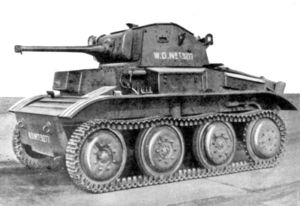
Last updated on February 17th, 2019 at 09:50 pm
Vickers built the A17 Light Tank Mark VII Tetrarch in 1937.
It had a unique suspension which included large road wheels that could be partially skid-steered. This helped the tank to turn more efficiently.
The Tetrarch, which was originally known as the Purdah, was accepted by the British Army in 1938. However it could not be produced until 1940.
By that time, armored cars had taken over the reconnaissance duties of light tanks, so that the A17 was obsolete by the time production could take place.
About 180 Tetrarchs were built. Some were sent to the Soviet Union as part of the Lend Lease program.

A squadron saw action in May 1942 in Madagascar. These tanks proved to have inadequate cooling, which made them unsuitable for desert action.
In 1943, they were given a new role as air-portable tanks for supporting airborne forces. The Hamilcar glider was specifically designed to carry them.
Some of these tanks saw action on D-Day, while others saw action at the Rhine Crossing.
In some Tetrarchs, the usual 2 pounder was replaced by a 3 inch (76.3 mm) howitzer so that the tank could be used for a close-support role.
A17 Light Tank Mark VII |
|
|---|---|
| Active: | 1942 |
| Crew: | 3 |
| Weight: | 7.5 tons (7,620kg) |
| Length: | 13ft 6 in (4.11m) |
| Height: | 6ft 11.5in (2.12m) |
| Width: | 7ft 7in (2.31m) |
| Weapons: | Main – 2 pounder QFSA (quick-firing semi-automatic) gun Secondary – 1 x coaxial 0.312 inch (7.92mm) Besa machinegun |
| Armor | Maximum – 0.55in (14mm) |
| Engine: | Meadows MAT 12-cylinder Gasoline, 165hp |
| Speed: | 40 mph (64kph) |
| Range: | 140 miles (225 km) |
